#Marsilio sourcing
Text

Another joint Giovanni and Marsilio letter! This one to Naldo Naldi, who was Marsilio’s oldest friend. Like since they were children. Of the four letters to Naldo in the volumes, two of them are written jointly.
The ending to this letter to Naldo is Hilarious. Just like “we’re not inspired to be long winded, ciao bella”. Which to an old friend is a fine ending because obviously Naldo knew Marsilio (and Gio) loved him.
Gio & Marsilio: we love you but the muses aren’t talking to use right now. Love & kisses etc
Naldo:
Naldo: you two were either horny and distracted or down a platonic rabbit hole and distracted or some combo of the above.
Naldo: it’s fine.
I’m including the notes to this one because of the astrology references.

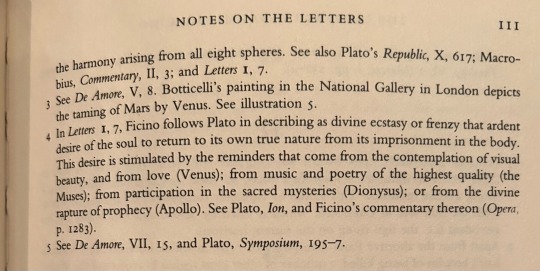
#marsilio ficino#Marsilio blogging#giovanni cavalcanti#Marsilio sourcing#early modern Florence#history#Renaissance Italy#Renaissance Florence#15th century
8 notes
·
View notes
Text

Marsilio Pasotti ''Pam'' (Scuderia Brescia Corse - Ferrari 512 M) Interserie - Imola 1971. - source Carros e Pilotos.
36 notes
·
View notes
Text
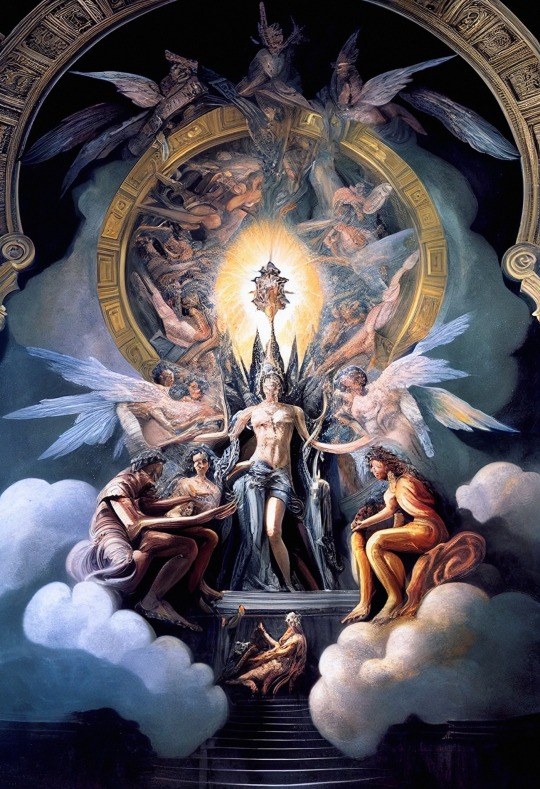
Orphic Hymn to Jupiter: Empower Your Jovial Prayers & Magic
Jupiter, known in traditional astrology as the Greater Benefic, would be an excellent place for many people to start building relationships with planetary spirits or beginning a devotional practice. The Renaissance magician-physician Marsilio Ficino advised as a general rule for people “to increase the influence of the Sun, of Jupiter, or of Venus.” Invocations, prayers, and offerings to a planetary spirit can help you attune to and come into rhythm with that planet. There are many ways to pray to or invoke a planetary spirit, including simply speaking from the heart, but a natural place to start is one of the most common and accessible prayers to Jupiter: The Orphic Hymn to Jupiter.
The Orphic Hymn to Jupiter
The Orphic Hymns are a collection of Hellenistic religious poems that were involved in the practices of Orphism, a mystery religion centered around the mythical figure Orpheus. The infamous magician Heinrich Cornelius Agrippa wrote that “nothing is more effective in natural magic” than the hymns of Orpheus.
The Orphic Hymn to Jupiter exemplifies one approach to planetary prayer, which is to regale the spirit with praise, listing many noble qualities and superlatives associated with that spirit. The traditional Orphic Hymn to Jupiter (Jove) reads as follows:
O Jove much-honored, Jove supremely great,
to thee our holy rites we consecrate,
Our prayers and expiations, king divine,
for all things round thy head exalted shine.
The earth is thine, and mountains swelling high,
the sea profound, and all within the sky.
Saturnian king, descending from above,
magnanimous, commanding, sceptered Jove;
All-parent, principle and end of all,
whose power almighty, shakes this earthly ball;
Even Nature trembles at thy mighty nod,
loud-sounding, armed with lightning, thundering God.
Source of abundance, purifying king,
O various-formed from whom all natures spring;
Propitious hear my prayer, give blameless health,
with peace divine, and necessary wealth.
Throne of Jupiter by Talon Abraxas
22 notes
·
View notes
Text
Anonymous asked: I don’t know if you caught King Charles III’s Christmas speech to the British nation but what did you think of it? I am a royalist but I always had my doubts about Charles and his championing of multi-faith harmony over his lack of Christian convictions (as opposed to the late Queen Elizabeth was a staunch Christian). Isn’t Charles just hastening the continued decline of the Christian heritage of Britain?
As it happens I did catch his Christmas broadcast as it’s very much part of the Christmas ritual in our home, like many other homes across Britain. This year it was very strange not to see the regal face of the late Queen. Her presence on television was very much part of the Christmas furniture as was the obligatory James Bond movie that often followed the broadcast. But there King Charles III was addressing the nation. It was perhaps the first time I truly realised that he was our king now - and I mean that as a compliment.
I’m afraid I’m not one of those who is convinced that Britain’s slide into Christian decline is perpetuated by King Charles III’s religious beliefs. When he delivered his Christmas speech to the nation, some were eager to read this into his words, just because he referenced other faiths other than Christianity. I understand the philosophical nonsense of squaring the multi-faith circle and worse how it can even dilute and undermine the distinctive and absolutist claims of non-relative religious movements so that they can be rendered increasingly irrelevant by an uncompromising secular rationalism. I understand all that. I just don’t buy it when it comes to King Charles III and his religious beliefs.
Of course before he became King, Charles’ view on religion, especially multi-faith beliefs, were always a source of alarm for some. He was accused of essentially showing sympathy for Perennialism - a school of thought which holds that there is some degree of truth in all the world’s traditional belief systems - and in doing so, Charles is guilty of undermining the exclusivity of Christianity and succumbing to a post-modern paradigm of cultural relativism. In holding this view he was seen by critics as heralding a world in which even the monarchy is too scared to defend its own values in the face of multiculturalism.

But listen carefully to the speech again and I struck by the reverence with which he spoke of his Christian faith. His emotive account of his visit to Bethlehem, where he “stood in silent reverence by the silver star that is inlaid on the floor and marks the place of our Lord Jesus Christ’s birth” is surely a welcome surprise in 2022, the first year in history where Christians are officially a minority in England and Wales. It is certainly not something one would expect from an apparently post-modern monarch indifferent towards the disenchantment of the country.
Still, instead of celebrating this, some remain cynical - the reason being that Charles, as well as praising the social and charitable contributions of the church, also praised those of synagogues, mosques, temples, and gurdwaras. This isn’t a slide into 21st Century relativism and simultaneously a compromise of his own Christian convictions, but a recognition of people of strong faith being good citizens in a country they love.

I think many critics underestimate King Charles’ own Christian convictions. I think he sincerely believes that there is one Light and one Truth in Christ. But it also dovetails with his soft Perennialist worldview in recognising the possibility for other faith traditions to also participate in that light and, perhaps, help to overcome the greater threat of secular modernity.
I’ve heard the argument from others that in fact Charles’ views on religion are remarkably similar to those of European Renaissance thinkers, who defended their appreciation of other faiths on traditional theological grounds. The 15th Century Italian Catholic priest Marsilio Ficino, for example, upheld the primacy of Christianity while also believing that other religions contained within them a glimmer of truth, the prisca theologia, and should be respected on this basis. For Ficino, this did not compromise his Catholicism; it simply showed that the love of God was universal, if perfected through Christ and Christ alone.
As it happens, other Renaissance thinkers saw this to be the ideal position for a monarch. For the 16th Century French political theorist Jean Bodin, the King should be the One above the Many, whose duty is to uphold the universal values shared by all people; to be the unity that transcends the multiplicity of sectarian difference. This entailed representing not only Christians of all denominations, but also Jews and Muslims. As an absolute monarchist, Bodin was deeply conservative by today’s standards, but even he saw it as perfectly acceptable for a King to honour subjects from religions other than his own.
So, as the argument goes, in living up to the ideals of Ficino and Bodin then Charles is some kind of Renaissance king. I’m not sure I completely convinced by that. But he is most certainly not a post-modern king. In many ways Charles is like his late mother in that he has a Christian faith - how strong is something I can’t determine, unlike the late Queen who was very devout and saw herself as a servant Queen serving her heavenly King. I am convinced Charles has Christian convictions and beliefs that are married to rituals of his royal identity.

In 1994, Charles triggered controversy when he said he would be defender of faith rather than Defender of the Faith, in a desire to reflect Britain’s religious diversity. There were suggestions that the coronation oath might be altered. In 2015, he clarified his position in an interview with BBC Radio 2, saying his views had been misinterpreted. He said: “As I tried to describe, I mind about the inclusion of other people’s faiths and their freedom to worship in this country. And it’s always seemed to me that, while at the same time being Defender of the Faith, you can also be protector of faiths.”
He pointed out that the Queen had said her role was “not to defend Anglicanism to the exclusion of other religions. Instead, the Church [of England] has a duty to protect the free practice of all faiths in this country. I think in that sense she was confirming what I was really trying to say - perhaps not very well - all those years ago.”
Now, as he formally ascends the throne at his coronation almost three decades after that controversy, most people would agree that Charles should champion the right to religious belief and practice of all his subjects, not just that of the dwindling number of people in the pews of Anglican churches.
G.K. Chesterton wrote that “the opponents of ritual attack it on the ground that it becomes formal and hollow. So it does. But ritual only becomes formal and hollow where men are not sufficiently ritualistic.” I think Charles is deeply steeped into royal rituals and traditions which are strongly rooted in the Christian history of these British isles. I’m sure you will see this at his coronation which will amplify his Christian convictions.
What do I mean by that?
In 1820, The Black Book, a radical critique of the corruption and power of the English Establishment, made this comment on royal ritual: “Pageantry and show, the parade of crowns and coronets, of gold keys, sticks, white wands and black rods; of ermine and lawn, maces and wigs, are ridiculous when men become enlightened, when they have learned that the real object of government is to confer the greatest happiness on the people at the least expense.” Forty years later, Lord Robert Cecil, the future third marquess of Salisbury, having watched Queen Victoria open parliament, wrote with scarcely more approval: Some nations have a gift for ceremonial. No poverty of means or absence of splendour inhibits them from making any pageant in which they take part both real and impressive. Everybody falls naturally into his proper place, throws himself without effort into the spirit of the little drama he is enacting, and instinctively represses all appearance of constraint or distracted attention.
As Sir David Cannadine, the great British historian, suggests, the elite's desire to temper the radical consequences of democracy was a crucial reason for their invention of so many royal rituals since the later nineteenth century. Indeed, for Cannadine, it is precisely the 'invention' and performance of royal rituals and Christian traditions, perfected at the end of the nineteenth and beginning of the twentieth century, which prevented the British monarchy from suffering the same fate as its Austrian, Prussian and German equivalents.

The Queen's coronation in 1953 was the first major international event to be broadcast on television, with an estimated 20.4 million viewers in the UK alone, 56% of the adult population. The coronation was the first media event seen by the majority of the population, and was for many their first experience of 'watching the box'. What people saw or were presented in the case of the British monarchy, were many references to its past by pointing out similarities between Elizabeth II and her famous predecessor Queen Victoria, by highlighting the longevity of rituals, or by implementing (seemingly old, but often invented) traditions in royal events like jubilees. In all of these cases, a diachronic genealogical link to the past is established in order to point to the institution's continuity, stability and anchorage in British history.
But Chesterton is onto something that has never really been talked about when we look what is behind the Christian symbology of rituals (real or invented).
Britain’s monarchy stands as the world’s only remaining state religious institution. The coronation is more than mainly a religious ceremony, as if that remaindered it for everyone not religious. It is a symbol among much else of the world’s oldest and only global narrative: God’s story. It goes all the way back to the crowning of Edgar by St. Dunstan in AD 973, drawing, it is said, an on even older Frankish ceremony. It takes place in Westminster Abbey, the national shrine. The oath is administered by the highest clergyman in the land. His office takes precedence even over the monarch himself. There is not just the formula “So help me God” repeated as does the U.S. president at the end of every secular statement; there is not simply an oath “upon my honour and integrity,” as in Turkey, or upon the honour of the nation, as in Ukraine.
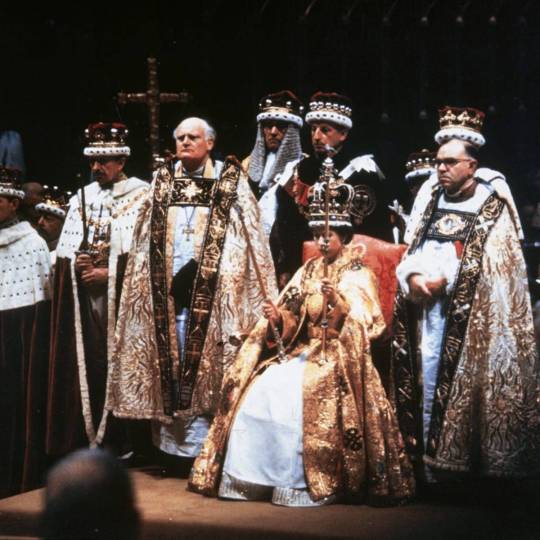
The new queen in 1953 was asked, “Will you to the utmost of your power maintain the laws of God and the true profession of the gospel?” And she, and now as Charles will, pledged to do this, kneeling at the altar of the greatest temple in the land, hand upon Bible; “the most valuable thing this world affords,” the priest intones. And of which the priest then adds:
Here is wisdom. This is the royal law. These are the lively oracles of God.
Then, in the even more amazing rite of unction that stretches in one unbroken line from the anointing of Solomon by Zadok the priest and Nathan the prophet in the Hebrew Bible, the king is anointed with oil under a gold awning in a ceremony of the utmost holiness. The archbishop hands him the symbols of his rule:
Receive this orb set under the cross, and remember that the whole world is subject to the power and empire of Christ our redeemer.
It is this that is the radioactive heart of Britain’s monarchy, and the secret of its strength. I think King Charles knows this. And so King Charles III will, I hope, defend faith in such a way that accounts for the universal and particular, all the while remaining committed to Christianity, the fabric of Britain’s history and heritage.
Both the monarchy and its rituals are together a protection against tyranny and a remedy for weakness. For, long forgotten by secular pundits, it models itself on the Christian belief that authority is what it is because it has been crucified; that only Christ the servant king is truly powerful, and because all are fallen, all can be restored only through him. King Charles III’s speech was a reminder of the eternal Light that will outlive the rise and fall of worldly civilisations; just what the nation needs to hear at Christmas.
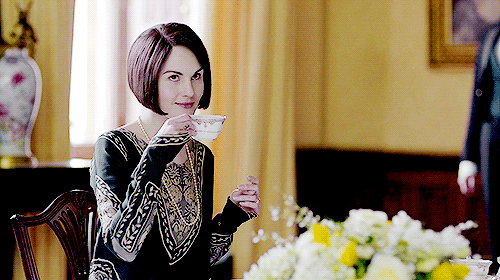
Thanks for your question.
#question#ask#king charles III#religion#christianity#christmas#heritage#tradition#multi-faith#britain#coronation#gk chesterton#perrrenialism#custom#society#queen elizabeth II#monarchy
52 notes
·
View notes
Text

"Lucrezia Tornabuoni's cultural patronage was not restricted to the visual arts. She indicated her interest in music and Italian poetry from the early days of her marriage. In March 1445, Rosello Roselli sent Giovanni di Cosimo de' Medici some music for a ballad and he also sent a copy to a musician named Ser Francesco, so that he could teach Lucrezia to sing it.
Michele di Giogante, an accountant and compiler of popular rhyme, dedicated two sonnets to Lucrezia during the early years of her married life. In the first, he began by describing her as:
'Magnanimous, noble, modest and pleasant,/charming, kind, wise, honourable and gay/' and ended the poem with reference to Lucrezia being 'Well-born to a deserving line'.
n the second poem, Giogante spoke of wanting '...to return to those who value you:/to the cage, or the lap of your Lucrezia'.
This was not only high praise, it was also indicative of his view of her as a valued patron who, like the Virgin Mary, was highly virtuous and a source of refuge and comfort.
Lucrezia was interested in supporting vernacular poets both secular and sacred and was friendly with many literary figures of Lorenzo's circle. She was a patron of Feo Belcari, Luigi Pulci, and Bernardo Bellincioni all of whom wrote vernacular poetry, as well as a friend of Angelo Poliziano, a humanist poet of renown. Lucrezia's literary patronage and her interest in Italian poetry rather than the Latin humanist tradition of Marsilio Ficino, reflected her personal literary preferences as well as her vernacular education. In contrast to Lorenzo, who received an education in both Latin and the vernacular, it would have been difficult for Lucrezia to take an active interest in Neoplatonism and other forms of humanist thought in Florence, because humanism was linked so strongly to the public realm of government."
Source: The Medici Women Gender and Power in Renaissance Florence, Natalie R. Tomas, Routledge, Monash University, Australia
#perioddramaedit#history#history edit#lucrezia tornabuoni#mediciedit#i medici#imediciedit#natalie dormer#donne della storia#donne nella storia#donne italiane#donneitaliane#women of renaissance#renaissance italy#renaissance women#renaissance#italian renaissance#italiansedit#historyedit#rinascimento#poliziano#lorenzo il magnifico#lorenzo the magnificent#lorenzo de medici#piero de' medici#medici masters of florence#medici: the magnificent#aesthetic#women in history#women of history
37 notes
·
View notes
Text
Abruzzo, Marsilio: "Campo lungo ha battuto il campo largo"
Il governatore confermato: “Schlein e Conte hanno parlato di barzellette come mia romanita'”source
View On WordPress
0 notes
Text
An Overview of Translation History: A Guide
During the history of translation, it has played a vital role in almost every aspect of humanity. Since primitive times, translators were now of great aid in the growth of languages, forming scholarships, and shaping national identities.
Numerous translators in the past have been addressed for their work, due in part to the lack of translators and similarly because what they translated made a vast impact on education, politics, religion, and other fields.

One of the most prominent was Saint Jerome, the supporter saint of translators, who decoded the Bible written in Greek and Hebrew into Latin, which became the certified version of the Bible used by Catholics.
Late Medieval to Early Renaissance
Gemistus Pletho (Plethon), a Byzantine researcher from Constantinople, went to Florence to restore the idea of Plato. He inclined Cosimo de Medici into founding the Platonic Academy, which was regulated by Marsilio Ficino, a scholar, and an Italian translator.
The Platonic Academy interpreted all the works of Plato, other works, and Plotinus’ Enneads’ works into Latin. Another major translation work during the 15th century is the language translation and free adoption by Thomas Mallory of ‘Le Morte d’Arthur,’ which consists of the tales of characters like Guinevere, Lancelot, Merlin, the Round Table, and King Arthur.
The rise of the west
The growth of the middle class and the advancement in the printing process during the 16th century further developed translation as the plea for new literary materials improved.
During this period, an English scholar called William Tyndale led a group to work on the primary Tudor translation of the New Testament in 1525.
One of his supporters finished translating the Old Testament, which was mass-produced in later years.
Transparency in Focus
In the latter part of this century, the standards of translation were faithfulness and transparency. Faithfulness means the scope of the translation’s accuracy in executing the source text into the target language while considering the features and context of the original.
Transparency in the translation means how close the text seems as if it was written in the target language while conforming to the target language’s grammar, syntax, and idiom and equating to idiomatic translation.
Start of the Industrial Revolution
Language translation services in this century are all about accuracy and style, with the translation policy focused on text. Because it is the Victorian era, coarse language was the exemption to the rule. Details in footnotes were also believed essential. Translators were meant to tell readers that the book or text they were relishing were translations of foreign examples.
19th Century influencers
The 19th century took several theories about translation. For Friedrich Schleiermacher of Germany, the translation can use two translation methods: foreignization or fidelity, which brings the reader to the writer, and domestication or transparency, which brings the writer to the readers.
Besides, the scholar and Chinese translator Yan Fu developed a three-facet translation theory in 1989, based on his wide-ranging skill in Chinese to English translation of social sciences documents. The theories are elegance, expressiveness, and faithfulness.
End of the 2nd millennium
Translation became more structured and prominent in the 20th century when reading the context of the written text became vital. Polish translator Aniela Zagórska, who rendered every work of Joseph Conrad into Polish, was given great instruction.
Joseph Conrad was her uncle, and Conrad observed translation as a skilled form that gives translators choices, which intended to interpret some of the text, on its place of just translating them.
The Present
Translation studies, which initially started in the latter part of the 20th century, is already an academic course today. It includes various subjects such as comparative literature, computer science, history, linguistics, philosophy, semiotics, and terminology.
It entails students choosing their strengths. When they specify, translators receive appropriate training either in legal, economic, technical, scientific, or literary translation.
Modern translators helped advance languages by borrowing terms and loanwords from a source language into a target language. The Internet and technology created a global market for language services, including the creation of localization services and translation software.
Evolving industry
Working as a translator unlocked new openings for bilingual people who obtain the required skills to be qualified translators. They learn to use language translation CAT tools and other memory tools to speed up the process of translating documents.
But the current situation is contrary to the status of translators from Ancient times until the primitive years. In the past, they accepted translators as authors, academics, researchers, and scholars but not anymore.
The Future
The future looks positive for the language translation services industry. Forecasts evaluate that it’ll turn out to be US$56.18 by 2020. Assume more changes in the supply methods of translations.
· With a maximum number of companies helping international clients, the need for effective and fast communication increases. Several translation companies will be presenting a full set of translations to meet the burdens of the market.
· There will be more calls for non-English languages.
· Progress in computer-aided productivity tools and CAT tools will lower the cost of translation.
Wrapping Up
It is difficult to ignore the surge in the use of machines to aid the translation process. But they are not dangerous to human translators. Relatively, they help enhance the work of translators. It’ll permit them to emphasize the actual translation of a document.
Confirm that you are getting the perfect translation by working with a qualified language translation service agency like Acadestudio.
If you interested in this type services please click here : https://www.acadestudio.com .
1 note
·
View note
Text
«Questo vino abruzzese è una m...», la battuta di De Sica diventa un caso. I produttori: «Offende il nostro lavoro»
«Questo vino abruzzese è una m…», la battuta di De Sica diventa un caso. I produttori: «Offende il nostro lavoro»
L’attore e la frase tranchant nel trailer del suo nuovo film «Natale a tutti i costi», ha scatenato la reazione del governatore abruzzese Marsilio e dei produttori abruzzesi
source

View On WordPress
0 notes
Text
☾✧゜BTS Numerology Chart | Heart's Desire: a peek into their relationships and career ☾✧
Disclaimer: Look, we know the disclaimer by now, although numerology is heavily reliant on maths, it's still not a definite way to define someone as they have a lot of other phases to them as human beings. I am diving a little into uncharted territory as I usually don't speak about their sexual relationships but know that the observations here are applicable to every other person with the same number so it's impersonal. With that being said, for entertainment purposes only. Note that this reading is based on their romanized names.
What is the Heart's Desire Number? based on the softer parts of the self, it shows the inner and deepest cravings that the soul needs to grow and evolve.
Kim Seokjin ☾✧゜
Heart's Desire Number: 11
So it's a Master number, we are already starting off strong.
Seokjin is bound to have incredible manifesting power.
He's magnetic and wise while holding a very broad outlook in life.
Very curious and intuitive
Masterful leader in situations
He's got a fear of being limited in any aspect of life
Can sometimes doubt his power and vision.
He's prone to have his own business so that he isn't told what to do.
Takes things at his own pace and likes to have fun.
Natural charmer but are we even surprised?
Innately intelligent
He's VERY selective when it comes to partners.
Only interested in someone who has a common outlook in life as well as being equally committed to personal growth.
Listen- this man knows exactly what he wants and that is copious amounts of truth and integrity in any relationship.
He's living on the fast lane of life
Fitness is important on his day to day.
Has a very VERY busy schedule that doesn't help him stay committed.
Good sense of humour
Has zero trouble attracting people.
While he's apparently not lacking in the whole having a lot of different partners department, he's not easily impressed.
Number also determines an ultimate destination of greatness
Will definitely leave a mark on humanity.
Min Yoongi ☾✧゜
Heart's Desire Number: 3
Has a smile that lights up the world
Highly magnetic, everyone seems drawn to him.
His greatest asset is his imagination
Has a strong calling to express himself through music
Has a contaging wit and charm that others find inspiring
He enjoys the spotlight but not in an attention seeking way
His soul urge is to light up those around him.
He does tend to doubt himself and be very wary of other people.
When it comes to relationships, he's a hopeless romantic
He'll pull all the stops for someone he loves.
Definitely not afraid to put himself out there and express his feelings, which leads him to feel rejected if said feeling aren't recirpocrated immediately.
Has a history of countless heartbreaks yet he rebounds quickly.
Never finds himself single for long.
He's most probably had quite some partners of different types
Not interested in people that fall at his feet
He's bound to have his own business
AND leave his mark on humanity.
Jung Hoseok ☾✧゜
Heart's Desire Number: 2
He's a man with deep empathy, intuition and finesse
He seeks to understand those around him more than be understood.
He's incredibly diplomatic.
He tends to disagree with alphatype personalities.
His soul urge is to cooperate rather than be told what to do.
LOVES turning uncomfortable situations into peaceful ones.
He's rarely in conflict with others.
This man knows right away when something is off
He's too empathic and caring that he often gives too much of himself to others.
He's more into commitment than he is to a single life.
Thrives in partnerships
No sacrifice is too great when it comes to someone he loves.
However his vulnerability is bound to cause him heartache.
He loves more openly and deeply than others.
A natural charmer
Bound to own his own business.
Living in the fast lane at this point in life
Likely to be extremely successful
He's probably learning a second language
Has had his fair share of different type of partners, but not in a playbloy type of way.
Kim Namjoon ☾✧゜
Heart's Desire Number: 22
We've got another master number.
He's got everything to be wildly successful
Intuitive, powerful, and practical
Has a strong calling to be a masterful builder and to create a legacy that will support generations to come.
Bound to work on something that involves a large number of people.
Has very high ideals but is very down to Earth
Tends to overestimate abilities and takes on tasks that he is not yet prepared to tackle just to please others.
In relationships, he is very practical
He values growth and companionship more than he does love itself.
He's perceptive and romantic nonetheless
Bound to be extremely successful
Has had plenty of different types of lovers
Not impressed at all by shallow people.
Park Jimin ☾✧゜
Heart's Desire Number: 1
He has incredible talent and creativity
Isn't afraid of taking risks
He's always honest and true to himself
Completely dislikes being micro-managed at work and in his personal life
Refuses to play second fiddle or give into the demands of others unless it is to avoid serious conflicts.
His soul urge is to be in the lead, not carried along behind it.
In relationships, he's the one in charge.
He tends to be the one that calls the shots
Since he's used to being in charge, he needs to make an effort so as not to come across as too uncompromising.
He has a deep need for independence so he's very careful with who he gives his attention to.
When his heart is open he is very loyal
He's bound to be extremely successful
Is living on the fast lane of life
Will own his own business
He's had a lot of different types of partners so far yet he's selective due to how he carries himself.
Kim Taehyung ☾✧゜
Heart's Desire Number: 9
He's an old soul
Has deep intuitive wisdom
People are naturally drawn to him
He's very appreciative and caring
He goes for altruistic matters rather than logic
He always wants everyone to benefit from situations.
He's willing to give regardless of the cost for him.
Has a strong moral sense and natural compassion.
He tends to be impressionable which might make others take advantage of him.
He's a very romantic person.
Incredibly compassionate and understanding
He can become quite impersonal or neglect his feelings when preoccupied with helping others.
Even though, he's more loving and present than most.
He's great with people.
He's bound to own his own business.
Bound to be extremely successful
Has had a fair share of partners of all types yet he's not attracted at all to shallow people
Jeon Jungkook ☾✧゜
Heart's Desire Number: 8
He's one to move on quickly
Has a long list of achievements
And an ability to achieve great goals
He's a natural leader and a great source of security for others.
Has a strong call to be in a position of power.
Gets easily frustrated with people who slack off or think small.
The embodiment of go big or go home.
In relationships, he has very VERY high standards
Due to him being as ambitious as he is, he tends to lack emotional flexibility and neglects romantic gestures
Fun and adventure are his things
Is able to excel in a lot of stuff
He's likely to own his own business
A natural charmer.
He's innately intelligent.
Bound to be extremely successful.
Fitness is a big thing in his life.
Has had quite some partners of different types yet not in a bad way.
Not interested in shallow people/ people that don't fulfill his standards in some way.
FINAL THOUGHTS
I'd say for the most part it seems consistent with things that come out of readings, some of their pointers are REALLY straightforward on them being meant to be on the path they are (we'll explore the life path number sometime later on) but it does seem to point to them being big and successful both on their own and as a group since their numbers seem to cooperate amazingly. It does look to me like they're meant to either take over HYBE or have their own company. The 'plenty of partners' wasn't much of a surprise, they're men in their mid-late twenties, handsome, on top of the world, it is just funny to see most of them having 'high standards' yet having a lot of partners, seems to me like those standards are more applicable or more strictly applicable to a deeper/ more committed relationship.
Sources: Marsilio Ficino and Hans Decoz texts
91 notes
·
View notes
Photo

“Portrait of Marsilio Cassotti and His Bride Faustina” by Lorenzo Lotto (1523)
source: https://it.wikipedia.org/wiki/Ritratto_di_Marsilio_Cassotti_e_della_sua_sposa_Faustina
6 notes
·
View notes
Text
Ficino Fam-jam Update
Five MILLION years later, I have the names of all of Ficino's siblings (I was just missing one sister at this point, but still).


Full list: Cherubino, Agnola, Daniello, Anselmo, Beatrice, Arcangelo
I've been mucking around on the digital archives of the Biblioteca Medicea Laurenziana for Reasons and stumbled across one of Ficino's compiled works that includes a letter to his siblings about parental obligations.
I'm working through a (very rough) translation and can happily inform all of you that even at the age of 21 Ficino was already Like That.
But Agnola! Agnola was the name I was missing. Hello Agnola it is nice to finally see you.
And confirming that everyone was alive at least as of 1455 (the year date in the detail is wrong, it's MCCCCLV not MCCCLV). The earliest sibling death I know of is in 1462 when Anselmo died.
Side note: 1462 is the same year that Cosimo buys a house near the hospital of S. Maria Nuova and donates it for the duration of their life to Marsilio and his mother. I'm so curious about the details around that whole deal. All of this is a year after Beatrice's marriage, which occurred circa 1461.
double side note:
Innocent student: did Marsilio study at the university of Bologna??
Beleaguered Ficinian scholar: We Do Not ask the Bologna question.
(Not unless you want the ghosts of Kristeller, Marcel, and Corsi to rise from the grave and fist fight each other. ...I mean could be fun.)
(just read the following:)
And here opens a particularly complex and delicate chapter of Ficino's biography concerning his stay at the University of Bologna to deepen his study of the Peripatetic philosophers and dedicate himself to medicine. The hypothesis, advanced by Corsi and taken up by Della Torre, was refuted by Kristeller and partially rehabilitated by Marcel.
#marsilio ficino#marsilio blogging#marsilio sourcing#history#early modern florence#renaissance florence
7 notes
·
View notes
Photo

Targa contraste... Marsilio Pasotti ''PAM'' (Alfa Romeo T33/TT/3) et un transport personnel, en l'occurrence un tricycle motorisé, Targa Florio, 1973. - source Carros e Pilotos.
52 notes
·
View notes
Text
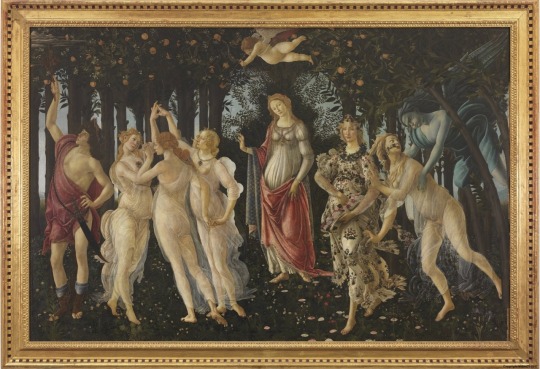
ICONOGRAPHY II: Botticelli’s Primavera
La Primavera is a modern title of convenience given to Botticelli’s picture, painted around 1478/80, of Venus standing in an orange grove with 8 other figures also drawn from classical mythology. The seasonal emphasis implied by that title is confirmed by the depiction of the transformation of Chloris, pursued by Zephyr, into Flora; by the figure of Mercury dispelling the clouds; and flower-strewn verdure. Vasari’s statement that the painting shows “Venere che le grazie la fioriscono, dinotando la primavera,” seemingly explains the relationship of Venus and the Three Graces to the vernal theme.
The painting is therefore not an illustration of a passage from an ancient text. Rather, figures and incidents from classical poetry and mythology have been lifted from their original contexts and grouped together to form a quattrocento allegory of Spring. Gombrich phrases this in more art historical terms when he affirms “the hypothesis that Bottcelli’s mythologies are not illustrations of existing literary passages, but that they are based on “programmes” drawn up ad hoc by humanists.”
However, as Gombrich also states in aside, Vasari’s description of “the Three Graces decking Venus with flowers” is inaccurate. The Graces dance, while Venus’ either directs the dance or keeps musical time. Shorn of its floral component, this group of figures cannot be said to “denote Spring,” and the hypothetical allegory of Spring collapses due to the lack of participation of nearly half of the painting’s figures. The allegory of Spring also fails to obtain if the actions of Mercury are interpreted not as the ending of bad winter weather, but applying the symbol and intrument of peace, the caduceus, to the clouds of war or civic dissension.
Reduced to the Flora group and a flowery ground, the allegory of spring would have to compete with one or two other allegories of uncertain meaning. It is unlikely that one of the eminent humanists employed by the Medici would have devised a disjunctive iconographic programme for a major artistic commission or have employed the machinery of allegory to signify a simple seasonal concept. Spring, therefore, is probably not the primary meaning of the picture.
Since Aby Warburg’s dissertation in Botticelli’s Primavera and Birth of Venus, scholars had accepted the poetry of Poliziano as the source of the picture’s iconography. Gombrich argued, however, that a letter from Marsilio Ficino to his student, Lorenzo di Pierfrancesco de’ Medici, provided if not a direct source for the picture’s iconographic program, then a particular, documented set of circumstances that suggest how it was intended to be interpreted. In his letter exhorting his 14-year old pupil to conduct him life virtuously, Ficino constructs an allegory consisting of pagan gods who represent virtues or qualities. For example, Jupiter is: the law, Mercury is reason, Mars speed, and Saturn slowness. Venus personifies not love, but humanitas, the Ciceronian ideal of an eloquent, urbane, cultured mode of existence emulated by the Florentine bankers.
Due to its wholly unconventional nature, Ficino’s alleogry required not only a detailed written exposition, but also the assistance of two other humanists who were asked by Ficino to reiterate and explicate it for his young pupil. Ficino also explains to his colleagues that visualizing his moral system as pagan deities will make the lesson more vivid and memorable. These efforts to instill in the mind of Lorenzo an understanding of Venus as humanitas takes place at exactly the moment when Botticelli’s picture of Venus was commissioned to decorate Lorenzo’s new residence. Gombrich argues that the young Lorenzo’s understanding of the painting would have been influenced by Ficino’s eccentric conception of Venus. Furthermore, Ficino and Botticelli were both members of the Neoplatonic circle of Lorenzo il Magnifico and both were employed by Lorenzo di Pierfrancesco. Given these circumstances, it seems likely that Ficino devised the iconography of the Primavera. The picture could therefore be understood as a collaborative effort by Ficino and Botticelli to instill in the younger Lorenzo Neoplatonically-inflected humanistic values that would inspire him to emulate the enlightened patronage of his uncle.
Edgar Wind strenuously criticizes Gombrich’s article in his discussion of the Primavera.
Ersnt Gombrich, “Botticelli’s Mythologies: A Study in the Neoplatonic Symbolism of his Circle,” Journal of the Warburg and Courtauld Institutes 8 (1945), 7-60.
Aby Warburg, Sandro Botticellis Geburt der Venus und Frühling: Eine Untersuchung über die Vorstellungen von der Antike in der italienischen Frührenaissance (Strasbourg, 1891).
Edgar Wind, Pagan Mysteries of the Renaissance (New York, 1958).
#italian painting - 15thc.#sandro botticelli#renaissance art#primavera#quattrocento#ernst gombrich#aby warburg#neoplatonism
31 notes
·
View notes
Text
O, Sun! purging all men's hearts with all your flames, do you wish so very much to be inaccessible to any mortal when, in fact, you are of all things most accessible to everyone? O, Sun! Source of Justice! Sun! Model of Generosity! As urgently as you incite me to seek you out, so shine back on me; with just such brilliance, with just such healing. Have I perhaps, dared to raise eyes that are too impure to the purest light?
Marsilio Ficino
16 notes
·
View notes
Text
Art History’s Iconic Depictions of Dreams, from the Renaissance to Surrealism

Jean Lecomte du Nouÿ, A Eunuch’s Dream, 1874. Courtesy of the Cleveland Museum of Art.
“When we fall asleep, where do we go?” This was the question looming over the long line of teenage girls who recently waited impatiently outside the Billie Eilish merch pop-up in Chinatown. The pop star didn’t invent this question. Philosophers, poets, and psychoanalysts have rhapsodized about the answer for centuries. It’s visual artists, though, who have, again and again, sought to show the impossible—to imagine, in pictures of sleeping subjects, the unseen places we go when we dream. From Godly visions to fantasies to nightmares, the representations of dreams in art have drastically changed since the Middle Ages.

Nicolas Dipre, The dream of Jacob, ca. 1500. Image via Wikimedia Commons.

Georges de la Tour, Dream of St. Joseph, ca. 1600. Image via Wikimedia Commons.
In the Renaissance, as artists and Humanists turned to the writings and art of antiquity, they discovered the ancient philosophers like Hippocrates and Aristotle had been tantalized by the subject of dreams. The 15th-century Florentine philosopher Marsilio Ficino, in particular, took up the task of interpreting the meaning of dreams. His concept of vacatio animae posits that while sleeping, the soul can be freed from the corporeal restraints of the body and achieve a higher, spiritual state.
In art, this spiritual state often took the form of a dozing soul caught in a religious moral dilemma. But dreams also allowed Renaissance artists to heroize the creative imagination and play with sensual, pagan scenes. The Venetian painter Lorenzo Lotto’s Sleeping Apollo and the Muses with Fame (ca. 1549) shows the naked deity napping in an idyllic glade. An angel flying overhead surveys the heaps of discarded clothes and musical instruments, while in the distance, the Muses—reveric stand-ins for the creative imagination—perform an uninhibited dance.
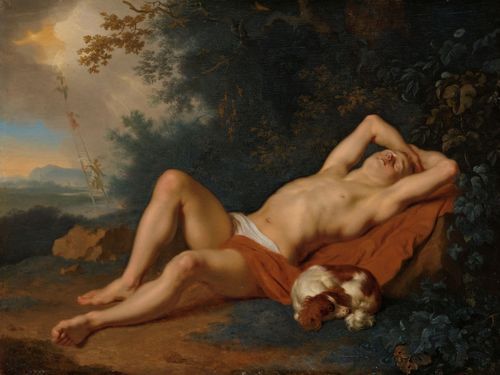
Ary de Vois, Jacob’s Dream, 1660–80. Courtesy of the Rijksmuseum.
Yet it was the Biblical dream—a communication from God—that artists were most often called upon to represent. The Old Testament stories of Jacob’s ladder and Joseph’s interpretation of Pharaoh’s dream were popular subjects. In both narratives, their dreams become important catalysts for change.
The dream of Jacob (ca. 1500), an oil-on-panel work by Nicolas Dipre, foregrounds Jacob, dressed ethereally in white, reclining outdoors with his head resting on a rock. His prophetic dream, in which angels mount a ladder to heaven, appears tangibly in the landscape behind his enclave. Jacob’s eyes may be closed, but his sight, the painting suggests, is clear.
Divine visions remained a popular challenge for centuries of Western artists, who imbued the well-worn stories with ulterior meanings. Ary de Vois’s version of Jacob’s dream (1660–80) is pointedly sensual. Jacob, nude save for a strategically placed bit of cloth, languorously stretches out on a patch of grass, his idealized body on full display. The ladder and angels appear far in the background, a decidedly less prominent focus of the picture compared with Dipre’s work. Here, Jacob’s vision from God is nearly ecstatic, offering pleasure to the sleeping figure much like Bernini’s famously erotic St. Teresa in Ecstasy (1647–52).
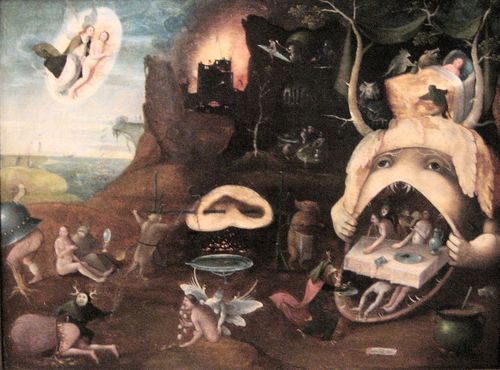
Followers of Hieronymous Bosch, The Vision of Tundale, ca. 1520–30. Image via Wikimedia Commons.
The stuff of nightmares was of little interest to the Italian or French Renaissance artists, who favored neo-Platonic ideals of beauty—until they encountered the disturbing fantasies of northern painters like Hieronymus Bosch. The Vision of Tundale (ca. 1520–30), attributed to Bosch’s followers, is a typically hallucinatory, “Boschian” scene. Inspired by the medieval poem “The Vision of Knight Tondal,” in which an errant knight dreams of his moral redemption after a vision of Hell, the painting depicts a spectacular and grotesque hellscape populated by monstrous creatures and graphic details. The work also takes on the idea of the nightmare as a phenomenon that is visited upon the living as a warning to repent for.Indeed, in the lower left-hand corner, the sleeping sinner Tondal is seen experiencing the nightmare firsthand.
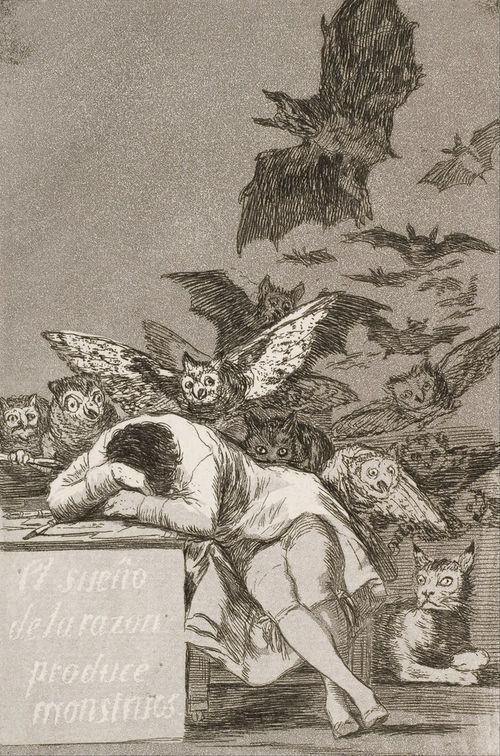
The Sleep of Reason Produces Monsters, No. 43 from Los Caprichos (The Caprices), 1796-1798.
Francisco de Goya
Nelson-Atkins Museum of Art, Kansas City, Missouri
Although the strictures of morality remain intact in The Vision of Tondal, when we slumber, the picture seems to suggest, reason sleeps too. Enlightenment-era artists made political statements about the irrationality exemplified by the nightmare. Francisco de Goya’s The Sleep of Reason Produces Monsters (1799) from his biting “Los Caprichos” series, employs the bad dream to criticize contemporary Spanish society, particularly pre-Enlightenment practices and superstitions the artist felt held the country back from modernizing. The central figure’s apparently peaceful sleep is interrupted, for the viewer at least, by the predatory creatures—associated, in Spanish folklore, with evil—that besiege him. Without the Enlightenment value of Reason, Goya forcefully asserts, evil wins.
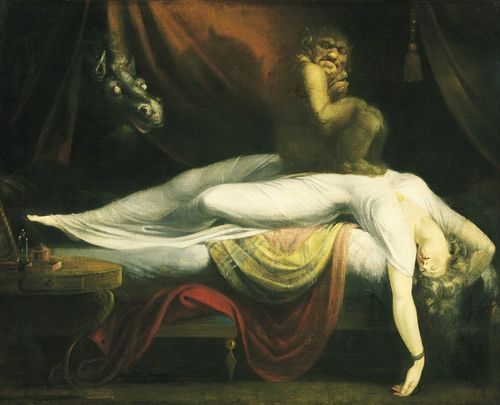
The Nightmare, 1781.
Henry Fuseli
The Detroit Institute of Arts, Detroit
Henry Fuseli’s famous Nightmare (1781) from around the same time would seem to suggest a similar narrative but is unusual in that it lacks a moral component, or even a literary, biblical, or art-historical precedent. The invented scene shows a woman in white stretched across her bed. A frightening incubus figure crouches on her chest while a horse with flared nostrils pokes its dark head out from behind a curtain. The work’s mysterious intentions and frightening imagery shocked audiences when it debuted, and seems to fall less in line with the “Age of Reason” than the ideals of Romanticism, in which European art and literature began to place value not on moral logic but emotion and spirituality. Some scholars today see the work as a prefiguration of Sigmund Freud’s psychoanalytic theories; Freud reportedly had a reproduction of the painting in his Vienna apartment.

Henri Rousseau, The Sleeping Gypsy, 1897. Photo by VCG Wilson/Corbis via Getty Images
Before Freud, however, in the 19th century, artists involved with the Symbolist movement developed novel means to express subjective psychological and spiritual realities through the landscape of dreams. Their subject matter features heady mixes of fantasy, eroticism, the occult, and death, often to puzzling effect. What is the meaning behind Henri Rousseau’s The Sleeping Gypsy (1897)? Is the lion that licks the sleeping woman’s face a product of her dream or a terror of reality? Is the woman really sleeping in the desert at all, or is the whole picture a dream?
When Freud did publish his theories on dreams and the unconscious, the effect on art was immediate. In the 20th century, dreams became primary source material for the Surrealists, who sought to transcend the constraints of rationality—and the oppressive societal rules that had led mankind to the First World War. The unconscious became a creative tool that contained unexpected meanings and a window onto one’s secret, inner self.
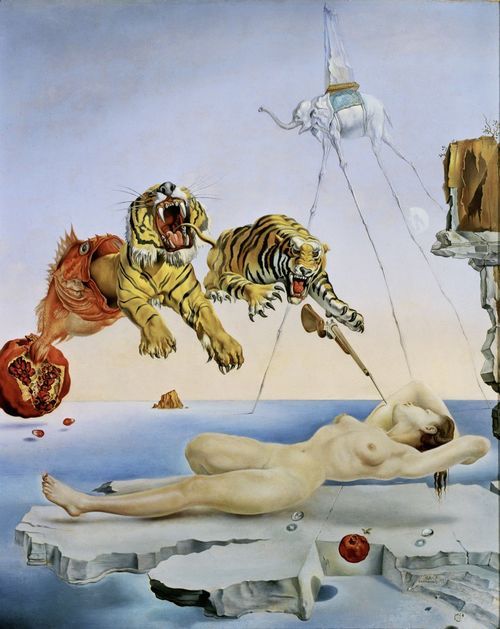
Dream caused by the Flight of a Bee around a Pomegranate a Second before Waking up, 1944.
Salvador Dalí
Museo Thyssen-Bornemisza, Madrid
Salvador Dalí interpreted dreams in his paintings in myriad ways, but it’s his 1944 work Dream Caused by the Flight of a Bee around a Pomegranate a Second before Waking, that takes on both the act of dreaming and its results in the same picture. The artist’s wife and muse, Gala, sleeps nude on a rock formation coming out of the sea. Gala’s dream manifests in the top half of the canvas, where two tigers and a rifle leap toward the resting figure from the mouth of a fish, which in turn emerges from a bursting pomegranate. As the title suggests, the onslaught of the dream will wake her moments later.
When we fall asleep, where do we go? Dalí, the Surrealists, and their artistic forebears understood the interpretive possibility of dreams as avenues for self-exploration. More importantly, they took full advantage of that question, relishing the creative freedom of the imaginative dreamscape.
from Artsy News
2 notes
·
View notes
Text
Regionali in Abruzzo, il rieletto presidente Marsilio parla di risultato storico
“I cittadini ci hanno dato fiducia. L’importante è la centralità dell’Abruzzo che vuol dire portare le risorse necessarie”source
View On WordPress
0 notes